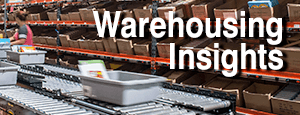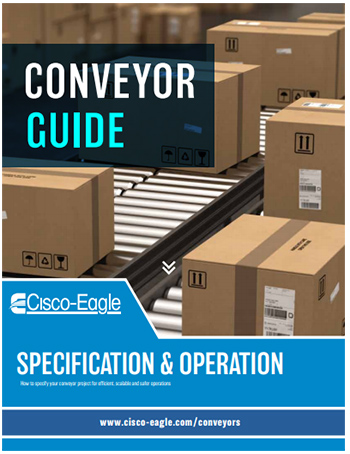Conveying Fruits and Produce
Speed, product damage and process stage considerations for fruits and vegetables
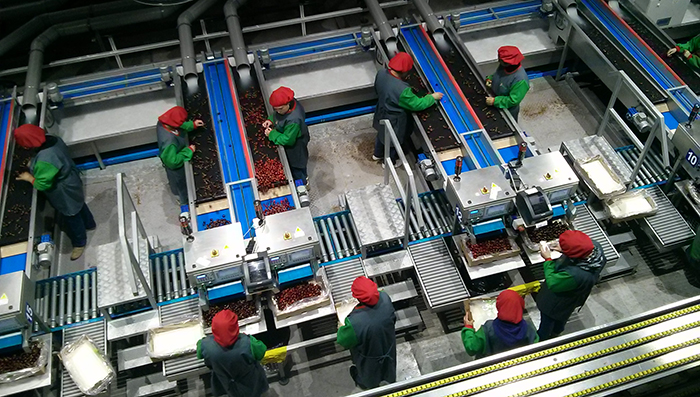
Conveyors used to transport, sort and deliver produce such as fruits and vegetables must be precise, sanitary and capable of carefully handling delicate foods. Production and packaging machinery should integrate with conveyor systems to ensure seamless operation. What are some produce conveying factors?
What are the applications?
Fruit and vegetable production may encompass pre-packaged, canned, frozen and fresh states. Conveyors are involved at every stage of the process from transport to sortation to packaging and outbound shipping. Conveyors are frequently integrated with fruit sorting machines that separate the produce by quality, color, size and other factors. Given the complexity of the process and the need to reduce touches and labor reliance, specifying your system the right way is more important than ever.
The need for speed
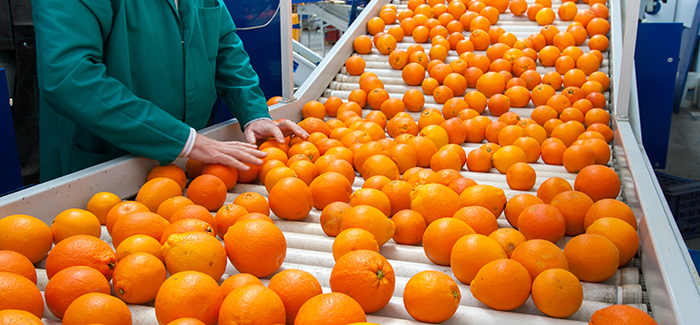
Above: some types of produce can be conveyed on rollers. In this application, oranges are being selected for quality before being fed to packaging lines
Because we’re conveying perishable loads of odd shapes and sizes, conveyors must be capable of both speed and precision handling.
While normal operating speeds aren’t too slow for produce conveying applications, these systems tend to push lots of product in specific timeframes and must serve packers or machinery downstream of induction. This means that the conveyor simply cannot be a bottleneck if you’re doing things like sorting fruits for packaging or refrigeration. The conveyor must deliver the product quickly and reliably to its end point.
When the conveyor feeds high-speed sortation, its throughput must be adequate to quickly transfer produce to the sorter.
Downtime is especially damaging for food conveyor applications
Because fruit and produce conveyors are delivering a fresh product that can spoil quickly, you can’t tolerate downtime. Reliability is a critical aspect of speed, especially in heavily seasonal harvest applications where the conveyor constantly runs to process large volumes of food, often through multiple shifts. The burden on your line is significant. To deal with this need for complete reliability, take these steps:
- Be diligent about maintenance. Always take the time to execute all recommended maintenance steps.
- Be ready for the season. If your harvest is seasonal, run the system well in advance and be sure it’s in tip-top condition before the crush hits.
- Stock spare parts. Most suppliers will provide you with lists of critical spare parts. Particularly in this era of crimped supply chain, you cannot afford to wait for a part to be shipped while your conveyor sits idle.
- Train your workers. Be sure everyone on the line understands conveyor operations so that the system isn’t damaged through misuse.
A growing market for fruits and vegetables: Rising incomes, health consciousness and improving economic status around the world will increase fruit and vegetable consumption. Efficient distribution and packing facilities must be optimized to cope with the demand.
Belts and roller specification
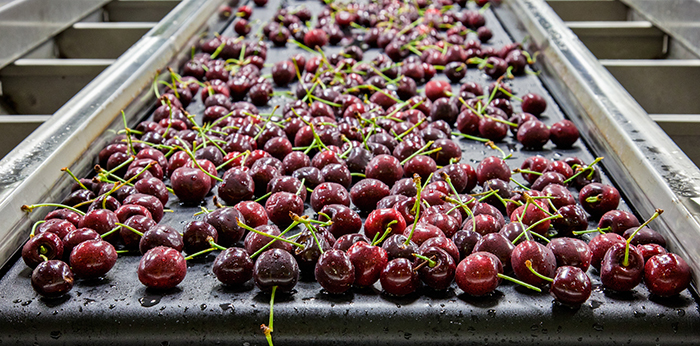
Above: cherries being transported on a moisture-resistant belt in a cleaning operation. Be certain to understand when and how your conveyors may be exposed to moisture
Belts can vary with the type of produce being conveyed
- Bulk berries and other fruit often do well on cleated belts, which help contain the product.
- Flat belts are suitable for produce in totes of adequate size.
- Modular plastic belts are often used in washdown applications.
- Rollers can be used for certain types of fruit and vegetable applications. You can specify plastic or plastic-coated rollers for washdown. For packaged produce, you can use rollers so long as you take care to ensure stems, pulp and other debris doesn’t damage conveyor mechanisms.
Sanitary and compliance demands
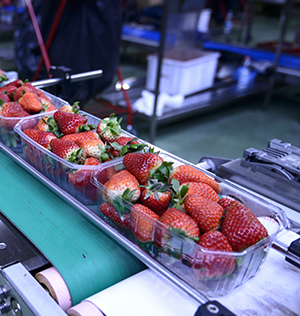
Depending on application and the nature of the line, you may need sanitary or washdown conveyors. All food handling applications from bulk transport to sortation to packaging must consider regulatory compliance and sanitation as they are specified, installed and operated. Plastic chain conveyors are frequently specified because of their versatility. Although not specifically a food-grade conveyor, plastic chain serves that role very well because it is easy to drain, wash down and service. Its plastic construction doesn’t slip as easily in wet environments, and it can handle most detergent and cleaning compounds. Bacteria growth is reduced on plastic chains.
Read more: The Food Safety Modernization Act focuses on foodborne illness prevention
Other factors for fruit and vegetable conveying
Uniformity: Package conveyor applications usually involve transporting and sorting a variety of carton sizes (or other loads like envelopes and blister packs), while produce conveyors are frequently specific to one type of fruit or vegetable. This narrower mission means that specifying the right conveyor from the very start is more critical for produce applications. These conveyors must also take roots, pulp or stems into account and reduce issues with those elements working into the machinery components.
Product damage worries: As you can imagine, product damage is a driving concern for fruits that easily bruise, which includes pretty much everything from apples to peaches. Melons break more easily than most packaged loads and also must be handled with care. Your conveyor must transport, sort and divert these loads gently.
Use overhead conveyors for carton packing
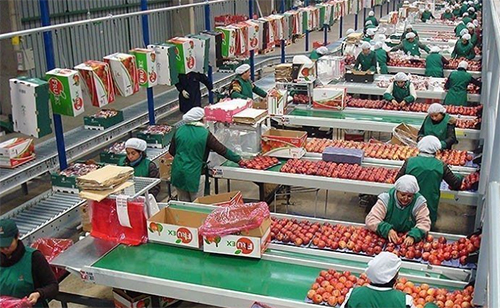
Above: workers in an apple-packing operation access cartons from an overhead conveyor system
In fruit packing operations, it’s more efficient to let the packers focus on packing and not carton forming or managing cartons while they work. If you separate the carton forming process from packing, both will run faster. The problem of providing packers with usable cartons is solved by using overhead conveyors to deliver formed cartons. Operators can easily take cartons off the overhead carrier. Ceiling-mounted overhead systems don’t interfere with intake lines, takeaway conveyors or packing operations because they use overhead space to deliver cartons.
This also increases fruit packing flexibility, since you can deliver multiple carton sizes and styles on the same overhead conveyor.
Download Cisco-Eagle’s guide to conveyors & systems
Well-executed conveyors and systems will optimize your operation–and we can help you make that happen. Cisco-Eagle’s detailed guide to conveyors gives you advice from our expert employee-owners, links, articles and more.
Download the guide today
Scott Stone is Cisco-Eagle's Vice President of Marketing with 35 years of experience in material handling, warehousing and industrial operations. His work is published in multiple industry journals an websites on a variety of warehousing topics. He writes about automation, warehousing, safety, manufacturing and other areas of concern for industrial operations and those who operate them.



